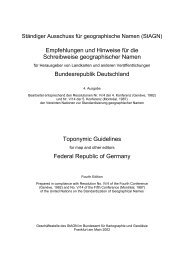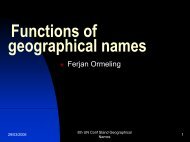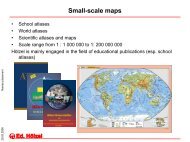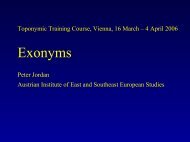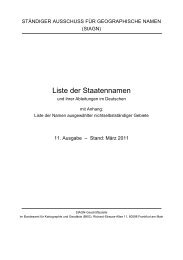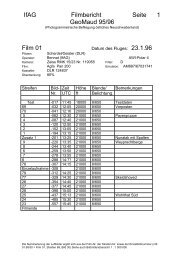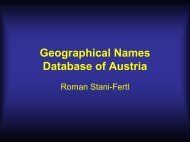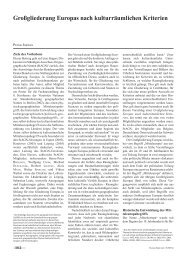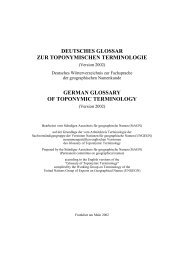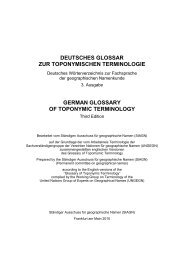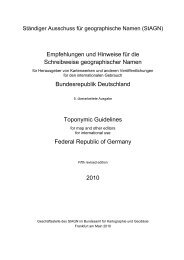NAMES ON MAPS FOR TOURISTS
NAMES ON MAPS FOR TOURISTS
NAMES ON MAPS FOR TOURISTS
Create successful ePaper yourself
Turn your PDF publications into a flip-book with our unique Google optimized e-Paper software.
<strong>NAMES</strong> <strong>ON</strong> <strong>MAPS</strong> <strong>FOR</strong><br />
<strong>TOURISTS</strong><br />
Trainings Course on Toponomy<br />
27 March 2006<br />
Bettina Wobek
IN<strong>FOR</strong>MATI<strong>ON</strong> <strong>ON</strong> <strong>MAPS</strong> <strong>FOR</strong> <strong>TOURISTS</strong><br />
• destination<br />
• routes<br />
• sights<br />
• attractions<br />
The tourist has to be able to read the map<br />
to understand it<br />
to identify and locate the places by the names given
OCCURRENCE OF TOP<strong>ON</strong>YMS<br />
• script/writing system<br />
• language (exonym/endonym)<br />
• data source<br />
• decisions and aims behind<br />
QUESTI<strong>ON</strong>:<br />
What can be detected about the use of names on<br />
maps for tourists?
Tourists gain relevant information using<br />
different types of publications<br />
Detailed Information<br />
(school)atlases<br />
road maps<br />
land surveys map editions<br />
.......<br />
>>> high quality products<br />
Overlook<br />
catalogues from tour operators<br />
brochures<br />
booklets<br />
travel guides<br />
>>> mass media products<br />
containing maps<br />
mass media maps<br />
clippings from high quality maps
tourism is global, script is<br />
not<br />
tourists can´t cope with<br />
unknown characters which<br />
are neither pronounceable<br />
nor retainable<br />
a conversion (transcription)<br />
takes place<br />
in tourism there is a rare use<br />
of foreign scripts, only some<br />
examples of double<br />
placement (e.g. online map<br />
of Macedonia) were found<br />
SCRIPT
Tourist map of Thailand<br />
(Thai brochure)<br />
• roman script<br />
• exonyms (English)<br />
• additional nonverbal<br />
information
LANGUAGE<br />
Tourist Language<br />
exonym or conventional name:<br />
Name used in a specific<br />
language for a geographical<br />
feature situated outside the<br />
area where that language<br />
has official status, and<br />
differing in its form from the<br />
name used in the official<br />
language or languages of the<br />
area where the geographical<br />
feature is situated.<br />
(e.g. Warsaw is the English<br />
exonym for Warszawa)<br />
Destination Language<br />
endonym:<br />
Name of a geographical<br />
feature in one of the<br />
languages occuring in that<br />
area where the feature ist<br />
situated.<br />
(e.g. Praha in Czech, not<br />
Prague (English) or Prag<br />
(German))
Route through Moravia<br />
(Dr. Maiers Studienreisen;<br />
German tour operator)<br />
• mainly exonyms (German)<br />
• historical exonyms (German)<br />
• few endonyms (Czech)
National Park Plitvice Lakes, Croatia<br />
(Nelles Guide, travel guide)<br />
• toponyms are endonyms<br />
(Croatian)<br />
• legend and additional information<br />
in tourist´s language (German)
Lonely Planet travel guide of Slovenia:<br />
Mix of languages, not<br />
comprehensible for user<br />
– Slovenian<br />
– English<br />
– Slovenian outside the borders<br />
– missing Italian in Slovenia<br />
– new exonyms<br />
Which name belongs to which language?
Lonely Planet travel guide of Slovenia:<br />
Mix of languages, not<br />
comprehensible for user<br />
– Slovenian (endonym)<br />
– English (exonym)<br />
– Slovenian outside the borders<br />
(not official)<br />
– missing Italian (official) in<br />
Slovenia<br />
– new exonyms as (transparent)<br />
compound names
TOURIST LANGUAGE VERSUS<br />
DESTINATI<strong>ON</strong> LANGUAGE<br />
(EX<strong>ON</strong>YM VERSUS END<strong>ON</strong>YM)<br />
pro Tourist Language<br />
• easier to read, pronounce<br />
and understand<br />
• familiar from school, TV<br />
etc....<br />
• right of the tourist to use<br />
his own language<br />
pro Destination Language<br />
• international conversation<br />
easier<br />
• identification on signs<br />
• orientation at destination<br />
possible<br />
• tourism is a global market<br />
The situation given is, that the reduction of exonyms, as<br />
recommended from UNGEGN is only partly carried out in<br />
publications for tourists. Travel guides and information sheets<br />
are more likely to avoid exonyms than booklets from tour<br />
operators. It’s against their policy to promote their destinations<br />
by using unfamiliar names.
MISTAKES IN USE OF EX<strong>ON</strong>YMS<br />
Use of exonyms leads to a variety of error sources in:<br />
• research<br />
• spelling<br />
• creation of new exonyms<br />
by translating the generic part of compound names<br />
(a toponym consisting of a generic and a specific element)<br />
e.g. Port (generic) Elizabeth(specific)<br />
– mistakes in translation, grammar, derivation<br />
– creating tautology<br />
– nonsense forms
CREATI<strong>ON</strong> OF NEW EX<strong>ON</strong>YMS<br />
The following example shows you what can happen to a lakes name:<br />
COUNTRY<br />
END<strong>ON</strong>YM<br />
NEW EX<strong>ON</strong>YM<br />
NOTE<br />
Slovenia<br />
Bohinjsko<br />
jezero<br />
Lake Bohnij<br />
translation<br />
Hungary<br />
Balaton<br />
Lake Balaton<br />
creating<br />
compound name<br />
Poland<br />
Jezioro<br />
Śniardwy<br />
Lake Sniardwy<br />
neglecting of<br />
diacritical mark<br />
Estonia<br />
Pühajärv<br />
Lake Pühajärv<br />
tautology<br />
because järv<br />
means lake<br />
This example shows, that the process of creating new exonyms is not<br />
that easy as it might seem.
C<strong>ON</strong>CLUSI<strong>ON</strong><br />
• the tourism industry should be aware of the problems<br />
• people in charge (editors/designers) should consider that the<br />
readability and identification of all toponyms is given<br />
• When unsing exonyms the historical/political background has to<br />
be considered<br />
• when using endonyms, explanations in the tourists language are<br />
necessary<br />
=>the easiest way to achieve maximum understandig would be to<br />
select the information represented on the map in order to have<br />
enough space for double names. These give the tourist double<br />
information by connectig familiar names with the situation at<br />
the destination!



